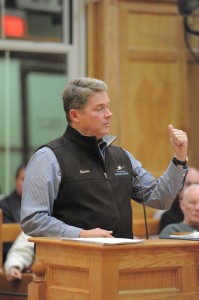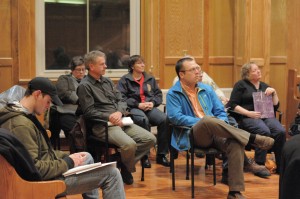
Barnes Regional Airport Manager Brian Barnes speaks to members of the Westfield City Council on changes to the present Part 150 Noise Mitigation program and its impact on residents in and around the city during the Feb. 6 meeting. (Photo by Frederick Gore)
WESTFIELD – The FAA has modified the criterion for resident participation in the on-going noise mitigation program initiated after F-15 fighter jets were moved from Otis Air Base on Cape Cod to the 104th Fighter Wind of the Massachusetts Air National Guard stationed at Barnes Regional Airport six years ago, replacing the A-10 ground support fighters, a much quieter airframe.
The noise mitigation program was initiated after a study of noise levels was conducted and boundaries based upon 70 and 65 decibels (dB) were established for the noise mitigation program for residents living near the airport.
Airport Manager Brian Barnes said at the City Council’s Feb 6 session that 364 houses were qualified for noise abatement, with 52 of the houses within the 70 dB zone and 312 in the 65 dB zone.

Audience members filled the Westfield City Council Chambers during the Feb. 6 city council meeting which included discussion of changes in the Part 150 Noise Mitigation program and its impact on residents in and around the airport. (Photo by Frederick Gore)
Residents in the 70 dB zone have the option of selling their homes, which would then be demolished. Those residents also had the option of accepting noise mitigation measures, which included replacement of window, doors, as well as adding insulation in the walls and central air conditioning to eliminate the need to open windows.
Residents living in the 65 dB zone were also qualified for the noise buffering modifications to their homes, but not for acquisition.
Barnes said that to date six houses in the 70 dB zone have been bought and demolished. Four more will be purchased and demolished this spring.
Barnes reported to the City Council last week that the Federal Aviation Authority, which has been funding $2.5 million annually for the noise mitigation effort, plans to change the program criterion to qualify for a full noise buffering modification to residences in the two target zones.
Barnes said that the program, under the original FAA criterion, was paying up to $88,000 per house for “acoustic treatment.”
“Now the new criterion makes it more difficult to qualify for that full modification,” Barnes said. “A lot fewer people will qualify for the full modification.”
Barnes said the new FAA program will go into effect in September of 2015. Under the revised noise mitigation program many residents will only qualify for $8,000 to install central air condition and an air exchange system.
“We’ll continue to work on this plan which we have to submit to the FAA in September of this year,” Barnes said. “We’ll continue to work to come up with a new game plan to apply for (future funding of the) grant.
“What we’re trying to do is complete (noise buffering modifications) in all of the homes on Holyoke Road and north,” Barnes said. “I will be seeking $240,000 to do all of those homes in the 2015 fiscal year budget, but don’t know if the FAA will match that level of funding.”
Barnes said that the focus will be to complete the house modifications in that neighborhood so that all houses receive the same treatment before the FAA criterion are in place.
“We want people to know these changes are coming, that the program funding is at the mercy of the FAA,” Barnes said.
Barnes also said that the city, under the FAA program revision, will be required to double its contribution, that since 2010 the city funded $70,000 a year, with the state offsetting the city’s share of the program, but that he will submit a funding request of $140,000 in his 2015 fiscal year budget.

